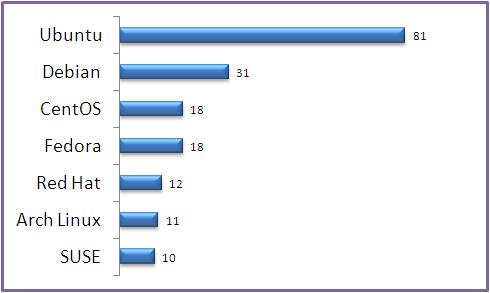Ubuntu
My personal favorite was Ubuntu for desktop (#1 in this list) and Red Hat for servers (#5 in this list).
If you are new to any of the distros listed in the top 5, read the rest of the article to understand a little bit more about those distros and find out whether your favorite Linux distribution made it in the top 5.

Fig: Favorite Linux Distribution Voting Results
1. Ubuntu

Like most of you, Ubuntu is my #1 choice for desktop Linux. I use it both at home and work. Ubuntu is the #1 in the Linux desktop market and some use Ubuntu for the servers also. Ubuntu offers the following three editions.
- Ubuntu Desktop Edition
- Ubuntu Server Edition
- Ubuntu Notebook Remix
Additional Details:
- Home Page: http://www.ubuntu.com
- Ubuntu Download Page
- Created by: Canonical Ltd., (who also provides commercial support, if you need it)
- Used As: Desktop and Server
- Latest Version: Ubuntu 9.04
- Read more about Ubuntu Distribution at wikipedia.
Refer to our Ubuntu Tips and Tricks article series.
2. Debian
Debian is also called Debian GNU/Linux, as most of the basic OS tools come from the GNU Project. A lot of other famous distributions are based on Debian, which includes our #1 distro Ubuntu and many others — such as Knoppix, Linspire, Damn Small Linux, etc.,
Additional Details:
- Home Page: http://www.debian.org/
- Debian Download Page
- Created By: Ian Murdock
- Latest Version: Debian 5.0.1
Read more about Debian Distribution at wikipedia.
3. Fedora

Fedora is sponsored by Red Hat. If you are interested in experimenting with the leading technologies, you should use fedora, as the release cycle is very short and fedora tends to include the latest technology software/packages in its distribution.
Additional Details:
- Home Page: http://www.fedoraproject.org/
- Fedora Download Page
- Created by: Fedora Project (sponsored by Red Hat)
- Latest Version: Fedora 11
- Based On: Red Hat Linux
Read more about Fedora Distribution at wikipedia.
4. CentOS

If your organization does not want to spend money on purchasing Red Hat support, but still want all the benefits of the red-hat distribution, this is obviously the best choice, as this is totally based on the red-hat enterprise Linux.
As you can imagine the Nort American Enterprise Linux vendor mentioned in the quote below is Red Hat.
From the CentOS website: CentOS 2, 3, and 4 are built from publically available open source SRPMS provided by a prominent North American Enterprise Linux vendor. CentOS is designed for people who need an enterprise class OS without the cost or support of the prominent North American Enterprise Linux vendor.
Additional Details:
- Home Page: http://www.centos.org/
- CentOS Download Page
- Created by: CentOS Project
- Latest Version: CentOS 5
- Based on: Red Hat Linux
Read more about CentOS Distribution at wikipedia
5. Red Hat

This is my favorite server distribution. If an organization doesn’t mind spending dollars on purchasing the red-hat support, this is always my #1 recommendation to any organization who runs mission-critical applications.
On a side note, one of the reasons I like Red Hat Linux for mission-critical production applications is that Red Hat tends to take some of the new features from Fedora, which is well tested by the community.
Additional Details:
- Home Page: http://www.redhat.com/
- Red Hat Download Page
- Created by: Red Hat
- Latest Version: Red Hat Enterprise Linux 5

0 Comments